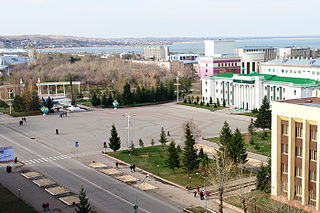
Astana, formerly known as Nur-Sultan, Akmolinsk, Tselinograd, and Akmola, is the capital and second-largest city of Kazakhstan with a population of 1,350,228 within the city limits after Almaty, which had been the capital until 1997. The city lies on the banks of the Ishim River in the north-central part of Kazakhstan, within the Akmola Region, though administered as a city with special status separately from the rest of the region. Initially founded as Akmoly in 1830, the city was later renamed Akmolinsk, Tselinograd, and Akmola before adopting the name Astana in 1998, which means "capital city" in Kazakh. In 2019, the city briefly adopted the name Nur-Sultan in honor of former president Nursultan Nazarbayev, but it returned to the name Astana in 2022.

Kokshetau, formerly known as Kokchetav between 1868 and 1993, is a lakeside city in northern Kazakhstan and the capital of Akmola Region. It stretches along the southern shore of Lake Kopa, lying in the north of Kokshetau Hills, a northern subsystem of the Kokshetau Uplands (Saryarka) and the southern edge of the Ishim Steppe. It is named after Mount Kokshe.

Kazakhstan is divided into 17 regions. The regions are further subdivided into districts. Three cities, Almaty, Shymkent, and the capital city Astana, do not belong to their surrounding regions.

North Kazakhstan Region is a region of Kazakhstan, with a population of 539,111. Its capital is Petropavl, with a population of 193,300 people.

Pavlodar Region is a region of Kazakhstan. The population of the region was 742,475 ; and 806,983. The latest official estimate was 756,511. Its capital is the city of Pavlodar, which had a population of 360,014 at the start of 2018. Many people, especially Ukrainians, migrated to Pavlodar in Nikita Khrushchev's Virgin Lands Campaign.

Karaganda Region is a region of Kazakhstan. Its capital is Karaganda. The region borders Akmola and Pavlodar Region to the north, Abai Region to the east, Jetisu, Almaty, and Zhambyl Regions to the south, and Kostanay and Ulytau regions to the west.
The 2001 Kazakhstan Premier League was the tenth season of the Kazakhstan Premier League, the highest football league competition in Kazakhstan, and took place between 28 April and 22 October.

Arshaly District is a district of Akmola Region in northern Kazakhstan. The administrative center of the district is the settlement of Arshaly. Population: 27,940 ; 29,620.

Nura District is a district of Karaganda Region in central Kazakhstan. The administrative center of the district is the settlement of Nura. The district has a population of 22,569 as of 2019.

Korgalzhyn is a village in the Akmola Region, Kazakhstan. It serves as the administrative center of Korgalzhyn District. The Nura River slowly flows around the selo. It is situated 120 km south-west of Astana. Population: 4,161 ;5,717.

The coat of arms of Astana, the capital of Kazakhstan, was originally adopted on 5 June 2008, and readopted on 18 November 2022, two months after the city's old name was restored by a constitutional amendment.

Akmola Region is a centrally located region of Kazakhstan. It was known as Tselinograd Oblast during Soviet rule. Its capital is Kökşetau. The national capital, Astana, is enclosed by the region, but is politically separate from Aqmola Region. The region's population is 715,000; Kökşetau's is 157,000.

Akmol, formerly Malīnovka until 2007, is a rural locality (selo) and the administrative center of Tselinograd District, Akmola Region, Kazakhstan, roughly 17 kilometres (11 mi) west of Astana. Population: 5,711 ; 4,835. As of 2012, it had a population of 5769 people. As of 2015, Zhanat Beisekeyev is the local akim (mayor).
Torgay Region was an oblast of the Kazakh Soviet Socialist Republic and of independent Kazakhstan from 1970 to 1988 and from 1990 to 1997. Its seat was in the city of Arkalyk. The region was located in the center of Kazakhstan, and its territory is currently divided between Kostanay and Akmola Regions.
Elections to the Akmola Regional Mäslihat were held on 10 January 2021 to elect the 32 members of the 7th Akmola Regional Mäslihat to coincide with the 2021 Kazakh local elections. It was the first election to be held under newly implemented proportional representation.

Municipal elections were held in Kazakhstan where 730 äkıms whose four-year terms expired were reelected for the first time directly by the population on 25 July 2021 following an introduction of new law by the Parliament, which allowed for direct elections for äkıms of cities with district importance, villages, and the townships of rural districts. From there, the ruling Nur Otan party won majority of 627 municipal races with most of its candidates being incumbents who occupied the äkım positions prior, followed by the Auyl People's Democratic Patriotic Party, Adal, Ak Zhol Democratic Party, People's Party of Kazakhstan, and the Nationwide Social Democratic Party where it secured local race victory in West Kazakhstan Region.
The Electoral district No. 2 is a single-mandate territorial constituency in Kazakhstan, represented in the lower chamber Mäjilis of the Parliament. It is located in the capital city of Astana and includes the districts of Esil and Saryarqa.
The Electoral district No. 9 is a single-mandate territorial constituency in Kazakhstan, represented in the lower chamber Mäjilis of the Parliament. It covers the entirety of Akmola Region, including all its regional districts, with its seat being located in Kokshetau.
The Electoral district No. 19 is a single-mandate territorial constituency in Kazakhstan, represented in the lower chamber Mäjilis of the Parliament. It is one of two constituencies within the Karaganda Region as its seat is centered in Temirtau, which includes the regional districts of Abai, Aqtogai, Qarqaraly, Nura, Sarybel and Shet.
Terengkol, formerly Kashyr until 2008, is a village in Pavlodar Region, Kazakhstan. It is the capital of Terengkol District and the administrative center of the Terengkol Rural District. Population: 7,355 ; 8,585.
















